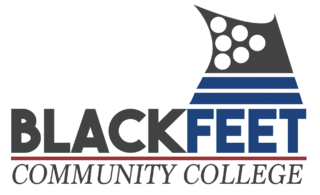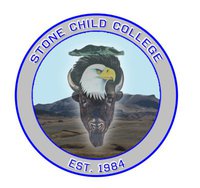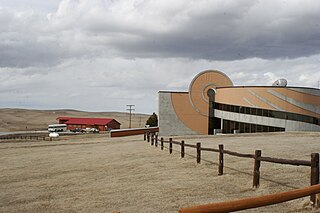Northwest Indian College is a public tribal land-grant community college in Bellingham, Washington. It was established by the Lummi Nation and is the only accredited tribal college or university serving reservation communities of Washington, Oregon, and Idaho.

Fort Peck Community College (FPCC) is a public tribal land-grant community college in Poplar, Montana. The college is located on the Fort Peck Assiniboine & Sioux Reservation in the northeast corner of Montana, which encompasses over two million acres. The college also has a satellite campus in Wolf Point.

Sitting Bull College (SBC) is a public tribal land-grant college in Fort Yates, North Dakota. It was founded in 1973 by the Standing Rock Sioux tribe of the Standing Rock Indian Reservation in south-central North Dakota. The SBC campuses are located in Fort Yates, North Dakota and McLaughlin, South Dakota. It serves as the primary educational institution on the Standing Rock Reservation.
Turtle Mountain Community College (TMCC) is a private tribal land-grant community college in Belcourt, North Dakota. It is located ten miles from the Canada–US border in Turtle Mountain, the north central portion of North Dakota. In 2012, TMCC's enrollment was 630 full- and part-time certificate and degree-seeking students.
United Tribes Technical College (UTCC) is a private tribal land-grant community college in Bismarck, North Dakota. In 2012, UTTC had an enrollment 885 students, 635 full-time undergraduates, and 250 part-time undergraduates.

Salish Kootenai College (SKC) is a private tribal land-grant community college in Pablo, Montana. It serves the Bitterroot Salish, Kootenai, and Pend d'Oreilles tribes. SKC's main campus is on the Flathead Reservation. There are three satellite locations in eastern Washington state, in Colville, Spokane, and Wellpinit. Approximately 1,207 students attend SKC. Although enrollment is not limited to Native American students, SKC's primary function is to serve the needs of Native American people.

Little Big Horn College is a public tribal land-grant community college on the Crow Indian Reservation in Crow Agency, Montana. It has an open admissions policy and welcomes enrollment from any adult with a high school diploma or GED. The student body is composed of Crow Tribal members, members of American Indian Tribes from around the intermountain west, and non-Indian residents of the Big Horn County area.

Sisseton Wahpeton College (SWC) is a Public tribal land-grant community college of the Sisseton Wahpeton Oyate on the Lake Traverse Reservation in South Dakota. It was established in 1979 and serves the Dakota people. SWC has an average enrollment of about 250 students, of whom more than 80% are tribal members. It has both vocational and academic programs, and arrangements with four-year colleges so that students can transfer for continued studies.

Little Priest Tribal College is a public tribal land-grant community college in Winnebago, Nebraska. It is a member of the American Indian Higher Education Consortium and primarily supported by the Winnebago Tribe of Nebraska. It has an enrollment of 135 students, of which 90 percent are American Indian.
Nebraska Indian Community College (NICC) is a public tribal land-grant community college with three locations in Nebraska: Macy on the Omaha Tribe reservation, Santee on the Santee Sioux reservation, and the urban South Sioux City.

The College of Menominee Nation (CMN) is a private tribal land-grant community college. Chartered by the Menominee Nation, the college's main campus is in Keshena, Wisconsin; another is in Green Bay, near the reservation of the Oneida Nation of Wisconsin. It is one of two tribal colleges in Wisconsin.

Leech Lake Tribal College (LLTC) is a public tribal land-grant community college in Cass Lake, Minnesota. It was established in 1990 and designated a land-grant college in 1994. The college includes approximately 70 faculty, staff, administrators, and 250 students. Most students come from the Leech Lake and Red Lake Reservations, and approximately 8% of the student population consists of non-Indian students.

Chief Dull Knife College is a public tribal land-grant community college on the Northern Cheyenne Indian Reservation in Lame Deer, Montana. It is an open-admission college with about 141 students. On average, more than half of its graduates move on to four-year colleges.
Lac Courte Oreilles Ojibwe College (LCOOC) is a public tribal land-grant community college in Hayward, Wisconsin. It is one of two tribal colleges in the state of Wisconsin. The enrollment averages 550 students. The LCOOC has a main campus in Hayward. More than one-third of students are enrolled at the four outreach sites at Odanah, Bayfield, Hertel, and Lac du Flambeau.

Blackfeet Community College is a private tribal land-grant community college on the Blackfeet reservation in Browning, Montana. The Blackfeet reservation occupies an area of 1,525,712 acres adjacent to Glacier National Park, Lewis and Clark National Forest, and the province of Alberta, Canada. In 1994, the college was designated a land-grant college alongside 31 other tribal colleges.

Stone Child College (SCC) is a public tribal land-grant community college in Box Elder, Montana. SCC is affiliated with the Chippewa-Cree Tribe and located on the Rocky Boy Indian Reservation in north central Montana; it is one of seven Tribal Colleges in Montana. In 2008–09, SCC had an enrollment of 511, of whom 98 percent were American Indian descent; 20 percent were bilingual or of limited English proficiency. SCC students range in age from 17 to 72, with the average age at 30. The college retention rate is 47 percent and the graduation rate is 20 percent.

Tohono Oʼodham Community College (TOCC) is a public tribal land-grant community college in Sells, Arizona. TOCC's student body is 88 percent American Indian/Alaskan Native. Tohono Oʼodham Community College serves approximately 216 students. The college's faculty and staff is 57 percent American Indian, half of whom are Oʼodham.

Keweenaw Bay Ojibwa Community College (KBOCC) is a public tribal community college in Baraga, Michigan.
Navajo Technical University (NTU) is a public tribal land-grant university in Crownpoint, New Mexico, with sites in the towns of Chinle, Arizona and Teec Nos Pos, Arizona. NTU is the largest tribal college in the country and is a 1994 land grant university. It has been accredited by the Higher Learning Commission since 2005 and is home to the first accredited veterinary technician program on an Indian reservation.

Oglala Lakota College (OLC) is a public tribal land-grant community college in Kyle, South Dakota. It enrolls 1,456 students enrolled part- and full-time. OLC serves the Pine Ridge Indian Reservation, which has a population of about 26,000 and covers 3,468 square miles in southwestern South Dakota.
















